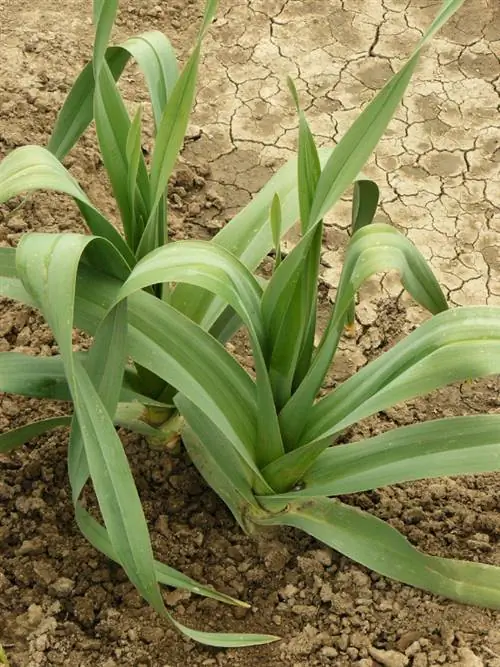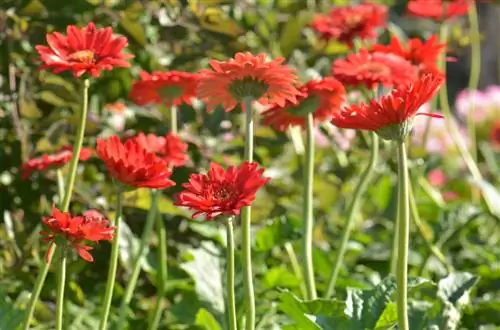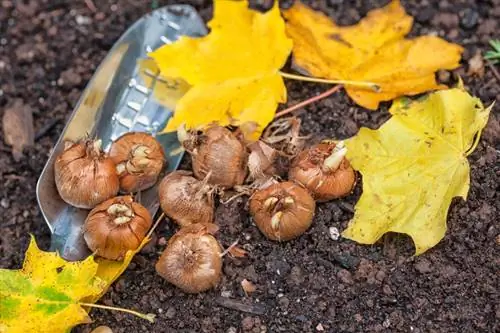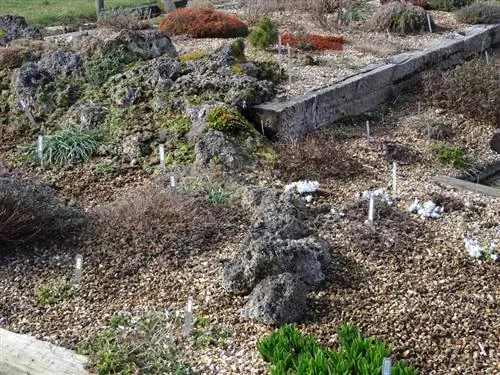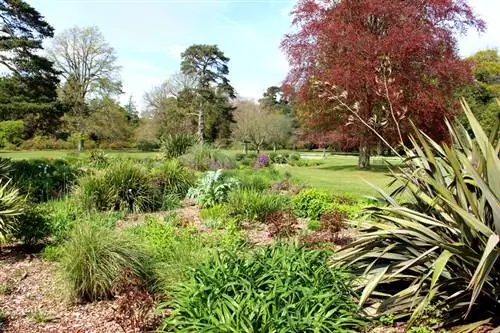- Author admin [email protected].
- Public 2023-12-16 16:46.
- Last modified 2025-06-01 06:02.
Read a commented profile about the hawthorn hedge here. Which hawthorn should you buy? How do you plant and care for a hawthorn hedge? Well-founded answers to read.
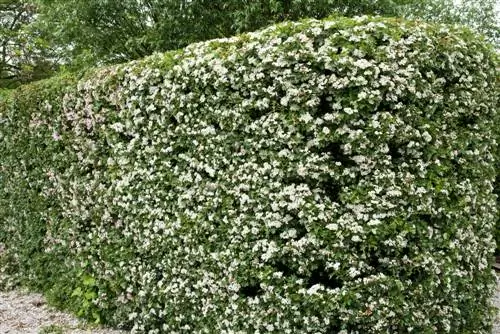
How do you grow and care for a hawthorn hedge?
With its dense, summer-green foliage structure, a hawthorn hedge provides privacy and a habitat for animals. It grows quickly 20-40 cm per year, has white flowers and red drupes. Planting is successful in normal, nutrient-rich soil, in sun to partial shade and with a planting distance of 4-8 per linear meter.
Profile
- Scientific name: Crataegus monogyna
- Family: Rosaceae
- Synonym: invasive hawthorn, hawthorn
- Occurrence: Europe
- Growth type: shrub, small tree
- Growth height: 200 cm to 800 cm
- Growth width: 100 cm to 500 cm
- Leaf: summer green
- Flower: white umbel panicle
- Fruit: Drupe
- Winter hardiness: hardy
- Use: hedge plant
Growth
With its naturally beautiful growth, invasive hawthorn is recommended as a premium choice for the natural hedge. The following key data illustrate why the native flowering tree has been one of the most popular hedge plants in Germany for many generations:
- Growth type: deciduous, lushly flowering shrub or multi-stemmed small tree.
- Growth habit: upright, densely bushy, richly branched with thorny twigs.
- Growth height: 2 m to 8 m (without pruning up to 12 m).
- Growth width: 1 m to 5 m (without pruning up to 8 m).
- Growth rate: 20 cm to 40 cm per year.
- Bark: dark brown with orange cracks and strong thorns.
- Roots: stable deep roots.
You can find out why you are making the right decision with a hawthorn hedge in the following video:
Video: Hawthorn hedge - a source of life for every garden
Bloom
The outstanding ecological value of a hawthorn hedge is based on its breathtaking display of flowers. The following characteristics characterize a hawthorn flower:
- Flowering time: May and June.
- Inflorescence: lush, umbel-shaped with up to 25 individual flowers.
- Single flower: five-petaled, cup-shaped, white petals, red stamens, 1 style, 8-15 mm in diameter.
- flower ecology: hermaphrodite
- Special features: intensely fragrant, rich in pollen and nectar.
- Pollinators: bees, bumblebees, butterflies, flies
With a nectar value of 2, hawthorn is one of the medium-sized traditional plants. It is the exuberant abundance of flowers that makes a hawthorn hedge a much-loved pasture for bees.
Leaf
A dense foliage serves as a green backdrop for the picturesque blossom festival. The summer green leaves decorate a hawthorn hedge even when it is not in bloom and protect your privacy from prying eyes. You can recognize a hawthorn leaf by these characteristics:
- Leaf shape: oval to ovoid, deeply lobed
- Leaf size: 5 cm to 7 cm long
- Leaf color: dark green
- Arrangement: alternate
- Autumn coloring: golden yellow
Hawthorn leaves are an important food source for the caterpillars of numerous endangered butterfly species, such as the magnificent sail butterfly (Iphiclides podalirius) or the nocturnal copper hen (Gastropacha quercifolia). The hawthorn hedge is highly valued by birds as an ideal breeding place. The densely leafy branches with long thorns are the perfect bulwark against furry hunters such as cats and martens.
Fruit
A hawthorn hedge says goodbye to the cold season with a remarkable play of colors of golden yellow leaves and red fruit decorations. Now ripe hawthorn fruits as a vitamin-rich food source make the hearts of hungry birds beat faster. All important fruit characteristics in a nutshell:
- Fruit ecology: Pome fruit
- Fruit shape: apple-shaped to egg-shaped, 8-10 mm long, with a hard stone core.
- Fruit color: dark red
- Fruit ripeness: from September
As hibernators, the red mini-fruits stay on a hawthorn hedge for many weeks and are only eaten by birds when they are brownish and fully ripe.
Planting a hawthorn hedge
Buying hawthorn as a hedge plant can be done for every financial budget. It is important to make a meticulous calculation, taking into account the planned hedge length and the desired privacy factor after planting. Choosing the right location is less of a headache. A knowledgeable planting technique ensures that hawthorn plants grow well. The calculated planting distance decides which hawthorn you should buy and at what price. Taking a look at these planting tips can save you a lot of money:
Buy hawthorn as a hedge plant
In nurseries you can buy hawthorn as root products, container plants or ready-made hedges. Inexpensive root products are not surrounded by soil, are cleared on site in autumn and immediately planted in the garden. The decisive advantage of container goods is a year-round planting period. Ready-made hawthorn hedges are the luxury version, which is reflected in the higher purchase price. The following table provides an overview:
| Buy hawthorn | Rootware | Containerware | Prefabricated hedge |
|---|---|---|---|
| Growth height | 40-60 cm | 40-60 cm | 60 cm high, 5 m long |
| Price per piece | from 1.09 EUR | from 3, 40 EUR | from 230.00 EUR |
| Planting spacing | 8 pieces per running m | 8 pieces per running m | ./. |
| Growth height | 80-100 cm | 100-120 cm | 120 cm high, 5 m long |
| Price | from 1.40 EUR | from 9.00 EUR | from 650.00 EUR |
| Planting spacing | 6 pieces per meter | 6 pieces per meter | ./. |
| Growth height | 125-150 cm | 150-175 cm | 200 cm high, 5 m long |
| Price | from 2, 19 EUR | from 22, 80 EUR | from 875.00 EUR |
| Planting spacing | 4 pieces per running m | 4 pieces per running m | ./. |
Please note: This table serves as a guide for purchasing hawthorn as a hedge and does not claim to be a representative price guide.
Location
These are the perfect conditions for a magnificent hawthorn hedge in the garden:
- Sun to partial shade (shade affects the abundance of flowers and fruit).
- Normal garden soil, preferably nutrient-rich, deep, calcareous.
- Exclusion criteria: waterlogging, acidic pH value less than 5, 0.
The influence of the elements on the location is irrelevant to a hawthorn. The tree thrives undaunted in bitter cold, stormy winds or midsummer heat.
Planting a hawthorn hedge
The best planting tips for a hawthorn hedge to read:
- The best time to plant is in autumn (October to April, as long as the spade gets into the ground).
- Stretched cords mark a dead straight line of the hedge.
- A planting trench simplifies row planting compared to individual planting holes.
- The trench or planting hole is twice as wide and deep as the root ball.
- Mix compost and horn shavings with the excavation for an extra portion of nutrients.
- First place hawthorn plants in water, then unpot and plant.
- The planting depth corresponds to the previous depth in the nursery (note dark soil marks as an indication).
- Extra tip: bare-root hedge plants are pruned vigorously so that they grow well.
Press the soil firmly with both hands. Take this opportunity to form a watering ring out of bed soil around each hawthorn and water thoroughly.
Excursus
Two-handled hawthorn - natural treasure with house tree qualities
Two-handled hawthorn (Crataegus laevigata) is a better choice for cultivation as a house tree. In contrast to the one-handled hawthorn (Crataegus monogyna), its two-handled counterpart is an impressive small-crowned hawthorn tree for front gardens and containers. Leading the way is the premium variety 'Paul's Scarlet' with a spherical crown and a height of 4-6 m. The white flowers with two styles and red anthers unfold two weeks before the flowering fairytale of the invasive hawthorn bush.
Maintaining the hawthorn hedge
A hawthorn hedge is very easy to care for. After planting, there is an increased need for watering for some time, which later reduces significantly. Starting fertilization in spring promotes growth and flowering. When cutting, protection from the nasty thorns is just as important as the timing and direction of the cut. You can read how to care for a hawthorn hedge in an exemplary manner here:
Pouring
Drought stress is the most common cause when freshly planted hawthorn hedges fail to grow. Therefore, keep the soil constantly slightly moist for the first four to six weeks. From now on, water thoroughly once a week if the drought persists.
Fertilize
Fertilizing is not mandatory in hawthorn care. The native wood is still grateful for additional nutrients in spring. In March/April, work a mixture of 3 liters of compost and 100 grams of horn shavings (€52.00 on Amazon) onto the root disc. A second helping at the end of June is good for a hawthorn hedge because this is when the flower buds begin to form.
Cutting the hawthorn hedge
As is typical for spring bloomers, a hawthorn bush sets its buds in the summer of the previous year. Furthermore, a hawthorn hedge is a retreat, pantry, nursery and bedroom for more than 160 animal species. The timing plays an important role so that maintenance and topiary pruning does not cause a massacre among the animal inhabitants or destroy valuable flower buds. How to trim a hawthorn hedge correctly:
- Cut hawthorn hedge after flowering and breeding season.
- Put on thorn-proof protective clothing.
- Cut the hedge into a trapezoid shape (wide base, narrower crown).
Over the years, dead wood accumulates in the deciduous hedge. The best time for a comprehensive thinning cut is during the leafless period, ideally in late winter. The pronounced pruning tolerance allows for radical rejuvenation pruning, as hawthorn sprouts happily again even from old wood.
Popular varieties
Single hawthorn is the ancestor of these beautiful varieties for natural garden design:
- Stricta: Pillar thorn with a slim silhouette, growth height 6-7 m, growth width 2-3 m, beautiful as a hawthorn tree and elegant hawthorn hedge.
- Compacta: compact hawthorn for small gardens with a height of 200 cm to 400 cm and a bushy, spherical habit.
- Corkscrew thorn: Rarity with bizarrely twisted branches and curved leaves, up to 300 cm tall.
- Glastonbury Thorn: impresses with two blooms in May/June and December on the old wood.
- Xanthocodon: colorful variety with yellow shoots, white flowers, red fruits and golden yellow autumn color.
FAQ
Should you avoid planting a hawthorn hedge due to the risk of fire blight?
Hawthorn is one of the most important host plants for the dangerous fire blight bacterial infection. For this reason, you should avoid planting a hawthorn hedge in regions with a risk of fire blight. A decorative alternative are resistant hedge plants, such as the large-leaved barberry (Berberis julianae), the native blackthorn (Prunus spinosa) or the majestic bird cherry (Prunus padus).
Which plant neighbors are suitable for the hawthorn bush for a mixed natural hedge?
Perfect planting partners for hawthorn are other wild fruit trees with comparable location requirements. These include dog rose (Rosa canina), black elderberry (Sambucus nigra), cornelian cherry (Cornus mas), common honeysuckle (Lonicera xylosteum), holly (Ilex) and privet (Ligustrum).
When is the best time of year to plant a hawthorn hedge?
The best time to plant a hawthorn hedge is in autumn. Hawthorn bushes are hardy down to -25° Celsius, so they grow well even in cold weather. The time window for inexpensive, bare-root trees is open from October to April. You can plant hawthorn in containers at any time of year, provided the soil is not frozen or completely dry.


